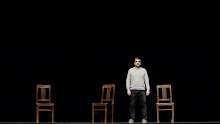uma recomendação já antiga do meu brother:
"Children playing is a typical example of spontaneous contact which can rise to higher levels,
but is also exemplifies another important fact: people are attracted by other people.
Just as children congregate spontaneously when a game starts, adults adore the sight
of everchanging human activities. Children play more willingly in driveways and
parking lots than in separate green areas, while adults invariably sit where it is possible
to watch life go by, rather than in private back gardens or enclosed parks. Even
city traffic is a great pole of attraction for adults and children alike, when it is not
excessive. We can observe that chairs in sidewalk cafe´s are always facing the street
and never towards the cafe´ or an empty space, people who stop to watch builders
at work go away during work breaks, those watching a pavement artist walk over
the picture without a second thought as soon as the artist leaves. More systematic
observations accompanied by simple statistics confirm these results suggested by
common sense but always ignored in city planning models. To get this virtuous circle
of activities and contacts, the various kinds of activities have to take place in the
same space. This co-presence is fundamental: people moving around for their jobs,
stopping for a breath of fresh air or to meet someone at a cafe´, sidewalk players,
street vendors or children playing, each one of these activities promotes the others.
City planning can do a lot to regulate human activities in space. Urban public space,
for instance, should not be too big so as not to inhibit the first level of optional
activities, watching, listening to and being seen by others. This means that both
horizontally?the width of the street?and vertically?the height of the buildings?
distances must enable one to see and to be seen clearly, according to the quality
which Sini has already noticed in “the city of words” of medieval times."
Futures 31 (1999) 437?456
The community and public spaces: ecological
thinking, mobility and social life in the open
spaces of the city of the future
Sergio Porta*
Department of Land and City Planning, Polytechnic of Milan, Milan,
Subscrever:
Enviar feedback (Atom)







Sem comentários:
Enviar um comentário